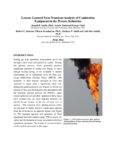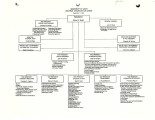TO
Filters: Collection: "ir_eua"
| Title | Date | Subject | Description | ||
|---|---|---|---|---|---|
| 126 |
 |
USTAR and SPE Salt Lake Petroleum Workshop, Utah Oil Shale Resources and Technology Update: Agenda | 2008-11-13 | USTAR; SPE; petroleum; oil shale. | The Utah Science Technology and Research Initiative (USTAR) and the Society of Petroleum Engineers (SPE) Salt Lake Petroleum Section are hosting a one-half day workshop on oil shale in Utah. The workshop will be from 8:45 a.m. through 1:00 p.m. on November 13, 2008. Breakfast and lunch are provided.... |
| 127 |
 |
Geologic summary report of the Sunnyside Tar Sands project, Carbon County, Utah | 1981-02-04 | geologic summary report; Sunnyside Tar Sands project; tar sands | The project area is located in the southwest portion of the Uinta Basin, near the northeast portion of the San Rafael Swell and localized within a small delta complex that formed in Lake Uinta during early Tertiary. The delta complex encompasses dimensions approximately 4-6 miles parallel to the anc... |
| 128 |
 |
APPENDIX G - Detailed study of shale pyrolysis for oil production - A subpart of project oil shale pyrolysis and in situ modeling - Final Project Report - Reporting period: June 21, 2006 to October 21, 2009 | 2009-04-21 | Oil production; Shale assessment | The oil shale industry is going through a revolution of sorts. After the oil crisis in the 1970s, a great deal of effort was spent on research and development and on pilot scale technologies. Extensive research was conducted with on-surface and in-situ production methods. Even though some large pilo... |
| 129 |
 |
Clean and secure energy from domestic oil sands and oil shale resources: Quarterly progress report - January 2014-March 2014 | 2014 | domestic oil shale; domestic oil sands; ICSE; CO2 management; liquid fuel production; in-situ thermal processing of oil shale; oil production | The Clean and Secure Energy from Domestic Oil Shale and Oil Sands Resources program, part of the research agenda of the Institute for Clean and Secure Energy (ICSE) at the University of Utah, is focused on engineering, scientific, and legal research surrounding the development of these resources in ... |
| 130 |
 |
Influence of the geological and geochemical characteristics of heavy oils on their recovery | 1987 | oil buoyancy; heavy oils; Likouala oil field; Emeraude oil field; water washing; oil saturation; biodegradation | The migration of an oil into a trap is governed by its buoyancy, the capillary pressure, and the hydrodynamic forces. For heavy oils the buoyancy is low; therefore, they can only saturate high-permeability zones, which are also preferentially swept by steam in a steam-drive recovery operation. Howev... |
| 131 |
 |
Sunnyside tar sand--comments on source, degradation, and maturity of the heavy oil | 1988-01 | Sunnyside tar sand; heavy oil; Sunnyside oil; mined tar sand; oil | Conclusions: 1. Many compounds in the Sunnyside oil have been seen in products from the Green River shale, indicating a Tertiary source for the heavy oil contained in the Sunnyside tar sand. 2. The absence of n-alkanes, branched alkanes, cyclohexanes, benzenes, naphthalenes and phenanthrenes, as wel... |
| 132 |
 |
Lessons learned from transient analysis of combustion equipment in the process industries | During gas flare operation, hydrocarbon gas is fed through a flare stack and ignited by a pilot. During the ignition process, flares generally produce significant amounts of smoke (see Figure 1) since enough mixing energy is not available to entrain surrounding air to completely burn the flare gas. ... | ||
| 133 |
 |
Modeling of asphaltenes: Assessment of sensitivity of 13C SSNMR to molecular structure | 2012 | asphaltenes; heavy oil; liquid hydrocarbon fuels; 13C SSNMR; molecular structure; refinery process | Asphaltenes are an important constituent of many oils and one of the major components in heavy oils sources for liquid hydrocarbon fuels. With light oil sources rapidly depleting, it is necessary to use alternative sources from heavy oil reservoirs. Refining these heavy oil resources presents new ch... |
| 134 |
 |
Fischer Assay Data, Utah Geological Survey Well Number U080 (b) | 2008 | This dataset contains the results of Fischer assay analyses obtained and published by the Utah Geological Survey for well U080. | |
| 135 |
 |
AQ_Research Agencies | |||
| 136 |
 |
Determination of sulfur anions in spent oil shale leachates by ion chromatography | 1989-07 | The leaching and transport of chemical constituents from spent oil shale disposal areas is an area of environmental concern at the present time. Sulfur-containing compounds are prevalent in spent oil shales and have the potential to leach into aqueous systems surrounding disposal sites. Computer mod... | |
| 137 |
 |
Quality growth efficiency tools: progress report | 1997-04 | The Quality Growth Efficiency Tools project team has been meeting since July 1996 to develop a process and set of tools to improve the quality of growth related information to plan for Utah's future. The Project's stated purpose is to improve the technical and analytical models used to forecast gr... | |
| 138 |
 |
User guide for characterizing particulate matter: Evaluation of several real-time methods | 2003 | This User Guide is intended to assist environmental or military personnel who work with air quality measurements, regulations, and planning for the Department of Defense. Specifically, it focuses on an evaluation of three newly developed instruments for characterizing particulate matter (PM), genera... | |
| 139 |
 |
Body (UUSAC: Cathey Eckart Chair) | University of Utah staff | Minutes, membership, organizational charts and other committee business. | |
| 140 |
 |
Characterization of particulate emissions: Size fractionation and chemical speciation | 2003-12 | Particulate emissions; Size fractionation; Chemical speciation; DoD emission sources; Aircraft ground support vehicles; Rocket motors; Aircraft; Sandblasting operations; Aerosol time-of-flight mass spectrometer; ATOFMS; Photoelectric aerosol sensor; PAS; Polycyclic aromatic hydrocarbons; PAH; Photoa... | This study developed and validated innovative techniques for characterizing the amount and composition of PM10, PM2.5, and smaller particles for four major classes of DoD emission sources: aircraft ground support vehicles, rocket motors, aircraft, and sandblasting operations. The techniques include ... |
| 141 |
 |
Quarterly Progress Report Phase 3: Clean and Secure Energy from Coal - April 1, 2012 to June 30, 2012 | 2012-07-01 | domestic coal resources; CO2 capture; stationary power generation; oxyfuel combustor (OFC) | The University of Utah is pursuing research to utilize the vast energy stored in our domestic coal resources and to do so in a manner that will capture CO2 from combustion from stationary power generation. The research is organized around the theme of validation and uncertainty quantification throug... |
| 142 |
 |
Standard 5: Educational Program and its Effectiveness | 2006-08-18 | The University of Utah in 1996: a report to the Commission on Colleges of the Northwest Association of Schools and Colleges. Standard 5: Educational Program and its Effectiveness | |
| 143 |
 |
University of Utah Staff Advisory Committee (UUSAC) minutes 1996 | 1996 | University of Utah employees | Minutes for the University of Utah Staff Advisory Committee. |
| 144 |
 |
UUSAC project 1997-1998 | 1998 | Funding; University of Utah campus projects | University of Utah campus projects sponsored by UUSAC |
| 145 |
 |
Clean and secure energy from domestic oil shale and oil sands resources: Quarterly progress report - April 2014-June 2014 | 2014 | domestic oil shale resources; domestic oil sands resources; ICSE; developing oil resources; CO2 management; utilization of oil shale and oil sands; liquid fuel production; in-situ thermal processing of oil shale | The Clean and Secure Energy from Domestic Oil Shale and Oil Sands Resources program, part of the research agenda of the Institute for Clean and Secure Energy (ICSE) at the University of Utah, is focused on engineering, scientific, and legal research surrounding the development of these resources in ... |
| 146 |
 |
AM_Administration and Faculty | |||
| 147 |
 |
California plio-miocene oils: Evidence of early generation | 1987 | plio-miocene oils; California oil; source rocks; commercial generation; LOM; hydrocarbon concentration; oil quality | Early generation of oil from Monterey and equivalent source rocks may well be the primary controlling factor on oil quality in the coastal basins of California. Commercial generation has occurred at reflectance levels as low as 0.3% R0. The wide range of chemical characteristics of these oils is com... |
| 148 |
 |
On-line, mass spectrometric determination of ammonia from oil shale pyrolysis using isobutane chemical ionization | 1988-03 | Ammonia is the predominant nitrogen-containing species formed during the pyrolysis of oil shale. An on-line method of determining ammonia was developed to study kinetics and chemistry of formation and evolution. While fragmentation of water interferes with electron ionization mass spectrometry, chem... | |
| 149 |
 |
Recycle oil pyrolysis and extraction of tar sand | 1989 | recycling oil pyrolysis; tar sand extraction; ROPE | Western Research Institute is developing a new pyrolysis process called ROPE© (Recycle Oil Pyrolysis and Extraction) for recovering products from tar sands that require a minimum of upgrading to produce finished, marketable fuels or that can be used as a diluent to decrease the pour point of bitume... |
| 150 |
 |
UUSAC president's staff awards 1993-1994 | 1994 | University of Utah staff awards | Notes, articles and memos on University of Utah presidential staff awards. |
